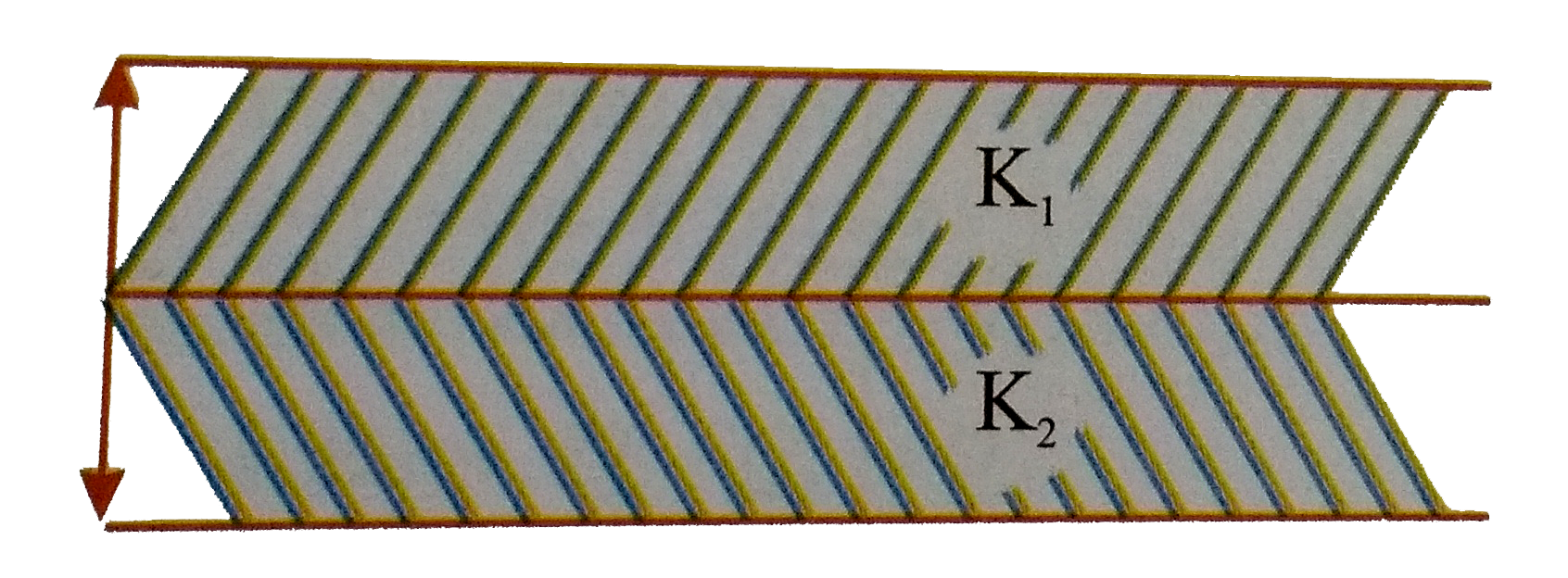A parallel plate capacitor is made of two dielectric blocks in series. One of the blocks has thickness d1 and dielectric constant k1 and the other has thickness d2 and dielectric constant k2 as shown in figure. This arrangement can be thought as a dielectric slab of thickness d = (d1+d2) and effective dielectric constant k. The k is ......

(a) K1d1+K2d2d1+d2
(b) K1d1+K2d2K1+K2
(c) K1K2(d1+d2)(K1d2+K2d1)
(d) 2K1K2K1+K2 Solution in Gujrati
K1d1+K2d2d1+d2
K1d1+K2d2K1+K2
K1K2(d1+d2)(K1d2+K2d1)
2K1K2K1+K2
The correct Answer is:C
Capacitance of a parallel plate capacitor filled with dielectric of constant K1 and thickness d1 is
C1=K1∈0Ad1
and for dielectric K2 and thickness d2 the capacitance of a parallel plate capacitor
C2=K2∈0Ad2
Both capacitors are in series so equivalent capacitance,
1C=1C1+1C2
∴C=C1C2C1+C2=(K1∈0Ad1)(K2∈0Ad2)K1∈0Ad1+K2∈0Ad2
∴C=K1K2∈0AK1d2+K2d1
So multiply the numberator and denominator by (d1+d2)
C=(K1K2∈0A)(K1d2+K2d1)×∈0A(d1+d2)
Effective capacitance ,
C=K∈0A(d1+d2)
Comparing equation (2) and (3)
K=K1K2(d1+d2)(K1d2+K2d1)
Topper's Solved these Questions
- ELECTROSTATIC POTENTIAL AND CAPACITANCEBOOK - KUMAR PRAKASHANCHAPTER - ELECTROSTATIC POTENTIAL AND CAPACITANCEEXERCISE - Section C ( NCERT Exemplar Solution ) ( Very Short ,Aswer Type Questions )
5 Videos
- ELECTROSTATIC POTENTIAL AND CAPACITANCEBOOK - KUMAR PRAKASHANCHAPTER - ELECTROSTATIC POTENTIAL AND CAPACITANCEEXERCISE - Section C ( NCERT Exemplar Solution ) (Short ,Aswer Type Questions )
5 Videos
- ELECTROSTATIC POTENTIAL AND CAPACITANCEBOOK - KUMAR PRAKASHANCHAPTER - ELECTROSTATIC POTENTIAL AND CAPACITANCEEXERCISE - Section B (questions)
2 Videos
- ELECTROMAGNETIC WAVESBOOK - KUMAR PRAKASHANCHAPTER - ELECTROMAGNETIC WAVESEXERCISE - BOARD.S QUESTION PAPER MARCH - 2020 (PART - B) SECTION - C
5 Videos
- MAGNETISM AND MATTERBOOK - KUMAR PRAKASHANCHAPTER - MAGNETISM AND MATTEREXERCISE - SECTION D Multiple Choice Questions (MCQs) (MCQs asked in Competitive Exams) MCQs asked in Board Exam and GUJCET
7 Videos
Similar Questions
Consider two conducting spheres of radii R1 and R2 with R1>R2. If the two are at the same potential, the larger sphere bas more charge than the smaller sphere. State whether the charge density of the smaller sphere is more or less than that of the larger one.
View SolutionProve that a closed equipotential surface with no charge within ilself must enclose an equipotential volume.
View SolutionA slab of material of dielectric constant K has the same area as the plates of a parallel plate capacitor but has a thickless (12)d. Where d is the separation of the plates . How is the capacitance changed when the slab is inserted between the plates
View SolutionDetermine the current in each branch of the given network.

View SolutionAt a place on earth the vertical component of earth's magnetic field is √3 times its horizontal component. The angle of dip at this place is …...
View SolutionIf d1,d2,d3 are the diameters of three ex-circles of a triangle then d1d2+d2d3+d3d1=
View SolutionLet d_(1),d_(2),d_(3),......,d_(k) be all the divisors of a positive integer n including 1 and n. Suppose d_(1)+d_(2)+d_(3)+......+d_(k)=72, then the value of (1)/(d_(1))+(1)/(d_(2))+(1)/(d_(3))+......+(1)/(d_(k)) is
View SolutionFind the capacitance between A and B if two dielectric alabs (each of area A ) of dielectric constants K_(1) and K_(2) and thicknesses d_(1) and d_(2) are inserted between the plates of a parallel plate capacitor of plate area A . .
View SolutionFind the capacitance between A and B if three dielectric slabs of dielectric constants K_(1) area A _(2) and thickness d_(2) ) are inserted between the plates of a parallel late capacitor of plate area A. (Given that the distance between the two plates is d_(1)=d_(2)+d_(2) .) .
View SolutionFind the capacitance of a system of three parallel plates, each of area A metre^(2) separated by distances d_(1) and d_(2) metre respectively. The space between them is filled with dielectrics fo relatives dielectric constants K_(1) and K_(2) . The dielectric constant of free space is in_(0) .
View SolutionA parallel plate capacitor is made of two dielectric blocks in series. One of the blocks has thickness d1 and dielectric constant K1 and the other has thickness d2 and dielectric constant K2 as shown in figure. This arrangement can be through as a dielectric slab of thickness d(=d1+d2) and effective dielectric constant K. The K is.
 .
.
View SolutionA parallel plate capacitor with square plates is filed with four dielectrics of dielectric constants K_(1),K_(2),K_(3),K_(4), arranged as shown in the figure. The effective dielectric constant K will be :
View SolutionSpace between plates of a capacitor (of area A ) is filled two dielectric slab of dielectric constant k1 and k2 .The capacitor is connected to battery of emf E then the charge stored on the capacitor will be (d2=1.5d1 and k1=2k2)
View SolutionSpace between plates of a capacitor (of area A ) is filled two dielectric slab of dielectric constant k_(1) and k_(2) .The capacitor is connected to battery of emf E then the charge stored on the capacitor will be ( d_(2)=1.5d_(1) and k_(1)=2k_(2) )
View Solutionएक समान्तर पट्ट संधारित्र के बीच का स्थान मोटाई d1 और d2 और परावैद्यतांक क्रमशः K1 और K2 की दो पट्टियों से भरा है। यदि संधारित्र की पट्टियों के बीच की दरी d है तथा d1=d2=d/2 तो संधारित्र की धारिता होगी :
View Solution
